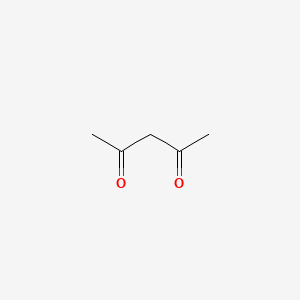| MeSH term | MeSH ID | Detail |
|---|---|---|
| Purpura, Thrombocytopenic | D011696 | 2 associated lipids |
| Eczema | D004485 | 4 associated lipids |
| Fetal Resorption | D005327 | 15 associated lipids |
| Carcinoma, Lewis Lung | D018827 | 22 associated lipids |
| Nervous System Diseases | D009422 | 37 associated lipids |
| Dermatitis, Contact | D003877 | 59 associated lipids |
| Seizures | D012640 | 87 associated lipids |
| Glioma | D005910 | 112 associated lipids |
| Edema | D004487 | 152 associated lipids |
| Adenocarcinoma | D000230 | 166 associated lipids |
2,4-pentanedione
2,4-pentanedione is a lipid of Fatty Acyls (FA) class. The related lipids are Butyrates.
Cross Reference
Introduction
To understand associated biological information of 2,4-pentanedione, we collected biological information of abnormalities, associated pathways, cellular/molecular locations, biological functions, related genes/proteins, lipids and common seen animal/experimental models with organized paragraphs from literatures.
What diseases are associated with 2,4-pentanedione?
There are no associated biomedical information in the current reference collection.
Possible diseases from mapped MeSH terms on references
We collected disease MeSH terms mapped to the references associated with 2,4-pentanedione
PubChem Associated disorders and diseases
What pathways are associated with 2,4-pentanedione
There are no associated biomedical information in the current reference collection.
PubChem Biomolecular Interactions and Pathways
Link to PubChem Biomolecular Interactions and PathwaysWhat cellular locations are associated with 2,4-pentanedione?
There are no associated biomedical information in the current reference collection.
What functions are associated with 2,4-pentanedione?
There are no associated biomedical information in the current reference collection.
What lipids are associated with 2,4-pentanedione?
Related references are published most in these journals:
| Lipid concept | Cross reference | Weighted score | Related literatures |
|---|
What genes are associated with 2,4-pentanedione?
There are no associated biomedical information in the current reference collection.
What common seen animal models are associated with 2,4-pentanedione?
There are no associated biomedical information in the current reference collection.
NCBI Entrez Crosslinks
All references with 2,4-pentanedione
Download all related citations| Authors | Title | Published | Journal | PubMed Link |
|---|---|---|---|---|
| Green TR and Popa R | Turnover of carbohydrate-rich vegetal matter during microaerobic composting and after amendment in soil. | 2011 | Appl. Biochem. Biotechnol. | pmid:21537893 |
| Silva SG et al. | Sequential spectrofluorimetric determination of free and total glycerol in biodiesel in a multicommuted flow system. | 2011 | Anal Bioanal Chem | pmid:21559757 |
| Pircher H et al. | Identification of human fumarylacetoacetate hydrolase domain-containing protein 1 (FAHD1) as a novel mitochondrial acylpyruvase. | 2011 | J. Biol. Chem. | pmid:21878618 |
| Pilalis E et al. | Escherichia coli genome-wide promoter analysis: identification of additional AtoC binding target elements. | 2011 | BMC Genomics | pmid:21569465 |
| Bernocchi G et al. | Developing central nervous system and vulnerability to platinum compounds. | 2011 | Chemother Res Pract | pmid:22312552 |
| Wu H et al. | Synthesis, Crystal Structure, and Spectra Properties of the Cadmium (II) Complex with Bis(N-allylbenzimidazol-2-ylmethyl)benzylamine. | 2011 | Bioinorg Chem Appl | pmid:22007154 |
| Srivastava RK et al. | Ameliorative effects of dimetylthiourea and N-acetylcysteine on nanoparticles induced cyto-genotoxicity in human lung cancer cells-A549. | 2011 | PLoS ONE | pmid:21980536 |
| Li M et al. | Yeast extract promotes cell growth and induces production of polyvinyl alcohol-degrading enzymes. | 2011 | Enzyme Res | pmid:21977311 |
| Premkumar T et al. | Shape-tailoring and catalytic function of anisotropic gold nanostructures. | 2011 | Nanoscale Res Lett | pmid:21974964 |
| Yang D et al. | Biogenic hierarchical TiOâ‚‚/SiOâ‚‚ derived from rice husk and enhanced photocatalytic properties for dye degradation. | 2011 | PLoS ONE | pmid:21931853 |
| Ovcharenko VI et al. | "Jumping crystals": oxygen-evolving metal-nitroxide complexes. | 2011 | Inorg Chem | pmid:21491890 |
| Ré VE et al. | Phylodynamics of hepatitis C virus subtype 2c in the province of Córdoba, Argentina. | 2011 | PLoS ONE | pmid:21611129 |
| Ran C et al. | Non-conjugated small molecule FRET for differentiating monomers from higher molecular weight amyloid beta species. | 2011 | PLoS ONE | pmid:21559413 |
| Tan M and Lu ZR | Integrin Targeted MR Imaging. | 2011 | Theranostics | pmid:21547154 |
| Babbs C et al. | Duplication of the EFNB1 gene in familial hypertelorism: imbalance in ephrin-B1 expression and abnormal phenotypes in humans and mice. | 2011 | Hum. Mutat. | pmid:21542058 |
| Sundar JK et al. | 1,1'-[4-(2,4-Dichloro-phen-yl)-2,6-di-methyl-1,4-di-hydro-pyridine-3,5-di-yl]diethanone. | 2011 | Acta Crystallogr Sect E Struct Rep Online | pmid:21523057 |
| Pérez N et al. | Reduction of iron by decarboxylation in the formation of magnetite nanoparticles. | 2011 | Phys Chem Chem Phys | pmid:21960123 |
| Gao Z et al. | Vanadyl bisacetylacetonate protects β cells from palmitate-induced cell death through the unfolded protein response pathway. | 2011 | J. Biol. Inorg. Chem. | pmid:21512771 |
| Frapper G et al. | Mechanisms of the Knoevenagel hetero Diels-Alder sequence in multicomponent reactions to dihydropyrans: experimental and theoretical investigations into the role of water. | 2011 | Phys Chem Chem Phys | pmid:21063611 |
| Guha G et al. | Therapeutic Potential of Polar and Non-Polar Extracts of Cyanthillium cinereum In Vitro. | 2011 | Evid Based Complement Alternat Med | pmid:19875433 |
